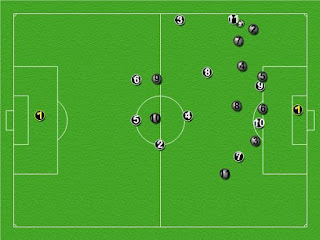FOOTBALL
GAME INTELLIGENCE
PART
1
How
to develop football game intelligence through the learning and teaching
process?
To ensure frequent
victories today, it is absolutely necessary to develop complete players. They
must have an excellent technical ability, physical fitness and tactical
knowledge; they must also be mentally prepared. But, there is one more aspect
of the development of a complete football player that have not been considered
or stimulated sufficiently in training to bring the game to a superior level.
That is the development of game intelligence in football.
Game intelligence is
the quality that allows a player to recognize and adapt to situations on the
football pitch quickly in the high pressure atmosphere of the match. However,
the development of the intellectual capacities of the players is still in its
very beginning, because of the authoritarian teaching style preferred by the
vast majority of coaches. For instance, the frequent instructions that the
players receive from the coaches before the game, during the game and during
the training sessions.
The
way to improve your players and the play itself is to begin a systematic
development of tactical awareness and thinking from a very early age with an
emphasis on a progressive stimulation of perceptive and intellectual
capacities.
How to teach the
players to think on their own when playing the game?
The children gain a
variety of experiences through observing, practicing and experimenting. Then,
they interpret these experiences when encountered with different and
challengeable situations during the game. Here, the role of the coach is to
guide the child and help him to interpret experiences properly, otherwise the
child will never reach his full potential. So, the coaches need to offer advice, to give examples and to question almost
everything.
Every coach should ask
himself, what is the best way for the children to acquire tactical habits? The
answer is very simple. All young players should be exposed as soon as possible
during training to simplified games in order to acquire football knowledge and
specific experience.
However, subjective
experiences alone are insufficient. The acquisition of knowledge is much better
when it is the result of a well-proven pedagogical process where the coach uses
questions and demonstrations to develop the specific knowledge. An explanation
or demonstration, stimulation, advice and encouragement by the coach will form
a solid foundation in the youngster’s mind for the development of game
intelligence. How to further build on this foundation is through appropriate
number of repetitions of the same game situation and then transfer of the
solution to similar situations that happen in the game.
Training
methodology to develop game intelligence
Coaches must use the
global rather than analytic method. The players should be exposed to a series
of technical-tactical simplified games like 2v1, 3v2 or 3v1. Practising
simplified games over and over again every player will face and resolve a series of problems that should
be shaped perfectly to his physical, technical and mental abilities. Bellow
will be outlined a couple of games and progressive exercises that will aid the
development of player’s tactical thinking and awareness step by step until he,
with the coach’s guidance, has discovered a number of solutions for every
situation confronted in a football game. The solution can be figured out
through spontaneity, imagination, creativity or through frequent repetition of
a similar situation in training.
The ability for
flexibility in a previously learned skill is only possible when the player has
been exposed to a systematic development of his intellectual capacity from a
very early age right through to a top performance level. Good perception, an understanding
of game situations and good decision making, culminates in a good technical
execution of the mentally prepared move. All these phases of the playing action
must be coached over a period of years in order to be able to raise the performance
level of any player.
The game intelligence
is a very important aspect in football. If you want to stimulate game
intelligence you as a coach must stop giving instructions and commands before,
during and after the match. Coaches must understand that instructing all the
time would prevent the players in developing their intelligence. Furthermore,
instead of providing solutions to the problems to the players, coaches should
confront the players in training with a variety of problems to be sort out by
themselves.
In
order to get more intelligent players with awareness and responsibility,
coaches must stop with the rigid and authoritarian coaching style as well as to
start to stimulate the players more and instruct less.
Developing game
intelligence means teaching the players to:
-
- Execute a previously devised solution quickly and with an appropriate skill level;
- Read the game and understand what is happening on the pitch;
- Draw on past experiences when confronting any given situation to come to a correct decision.
Intelligent players are
capable of reading situations within the game as well as anticipating how the
play is likely to develop thanks to previous information. The quality to
anticipate, as a result of good decision making and perception, is a
significant tool for intelligent players. Nobody has an inborn high level of
game intelligence. In order to develop the innate potential, you have to expose
your players every day to a progressive training program with simplified games.
Not only can simplified games develop game intelligence in player, but also
improve the tactical and technical skills.
In part 2 will be explained
what game intelligence looks like and how to use effective questioning in order
to improve your players and enhance their performance.


































